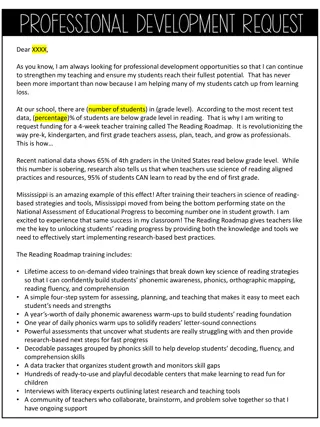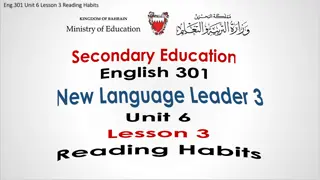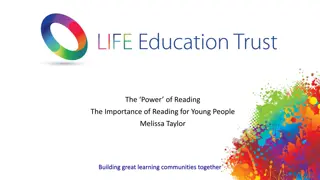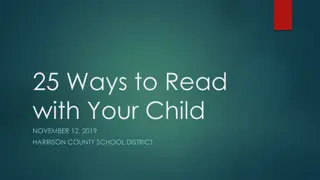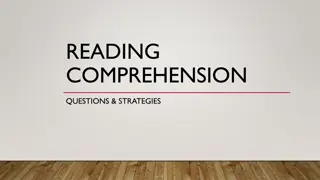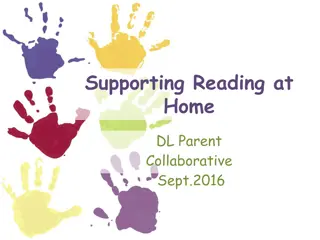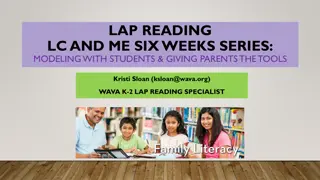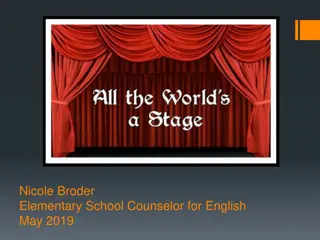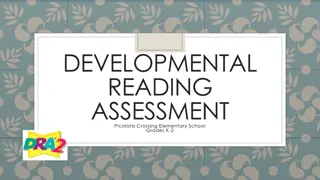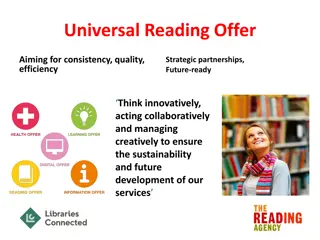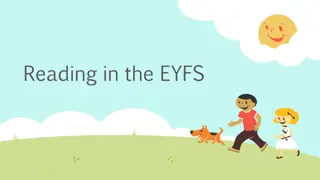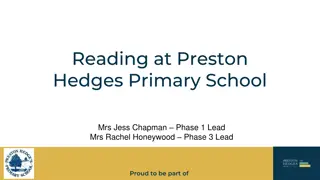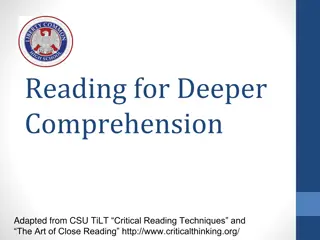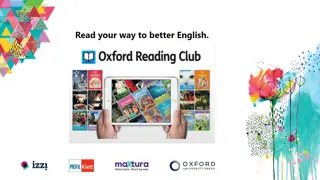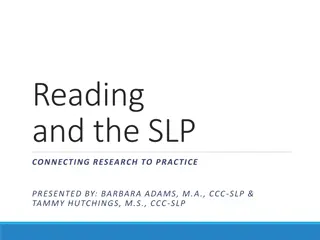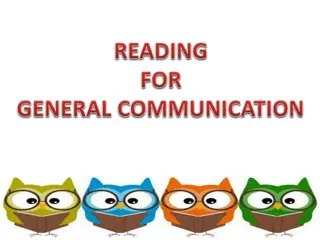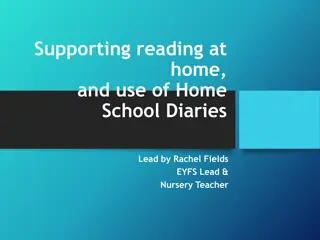The Science of Reading: Addressing Challenges and Solutions
Amid public interest and controversy surrounding the Science of Reading (SOR), this presentation addresses the challenge of aligning reading instruction, dispelling myths, and exploring how schools can better respond to student reading needs. Learn from an expert with over 50 years of experience in teaching and studying reading.
Download Presentation

Please find below an Image/Link to download the presentation.
The content on the website is provided AS IS for your information and personal use only. It may not be sold, licensed, or shared on other websites without obtaining consent from the author. Download presentation by click this link. If you encounter any issues during the download, it is possible that the publisher has removed the file from their server.
E N D
Presentation Transcript
The Science of Reading Timothy Shanahan University of Illinois at Chicago www.shanahanonliteracy.com
The Challenge There is great public interest in the science of reading (SOR) This has been expressed through parental pressure and legislative mandates The claim has been that reading instruction has not been sufficiently in alignment with SOR Pressure has been especially acute from the dyslexia community This controversy is concerning because of U.S. reading achievement is weakening
The Problem Disagreements in scientific community about SOR and new science is always emerging Some reading educators argue that they are entitled to their own science of reading Most educators aren t sure what SOR is Some companies trying to sell SOR (as if it were a product they owned)
The Solution Over the next 90 minutes, we ll explore what is included in a science of reading and how you can tell if instruction is aligned with SOR We ll dispel some of the myths that have sprung up around the concept We ll consider how schools can best respond to the reading needs of students and to the concerns of the community
Be forewarned: The contradiction of a belief causes cognitive dissonance that can be resolved by altering the challenged belief. Yet, instead of changing the belief, people often resort to misperception, rejection, or refutation of the contradiction, by seeking moral support from those who share the contradicted beliefs, or by trying to persuade others that the contradiction is unreal. Leon Festinger. (1957). A Theory of Cognitive Dissonance. Stanford University Press.
Why should we listen to you, Mr. Smarty Pants?
My Bona Fides I ve been teaching reading and studying reading instruction for more than 50 years I ve been a teacher s aide, tutor, student teacher, primary grade teacher, remedial reading teacher, clinic director, professor of education, reading researcher, school district administrator, curriculum writer, test designer, research journal editor, etc. I was a member and the scientific director of the National Reading Panel which summarized reading research for the U.S. Congress I chaired two other scientific review panels on reading instruction for the U.S. Department of Education (one on beginning reading and one on second language literacy)
My Bona Fides (cont.) Until earlier this year, I served on the editorial review boards of all the major journals in the field and I serve on IES s review panel As Director of Reading for the Chicago Public Schools and spearheaded research-based policies that led to higher reading achievement I was Researcher of the Year in the Social Sciences (2013) at my university and have received multiple research awards I m the only reading researcher to advise the What Works Clearinghouse since its inception
My Bona Fides (cont.) I advise several international bodies & governments on reading research and policy (Canada, UK, EU, UNESCO, Ireland, Luxembourg, Korea, World Bank, etc.) I ve published more than 300 articles, chapters, and books on reading education I ve served as President of the International Literacy Association I was appointed by the President of the U.S. and approved by the U.S. Senate to serve on the Board of the National Literacy Institute
History From Whence Comes SOR? I conducted an N-Gram study in Google s book collection I was surprised to find that the term SOR was first used near the end of the 18thCentury, and it came from what was then the new science of linguistics The original purpose of linguistics was to determine the proper pronunciations of holy texts in Aramaic, Hebrew, and other dead languages Within a couple of decades, the term had been taken over by American educators to refer to how they could ensure that students learned to put the proper pronunciations onto the words in their primers
History From Whence Comes SOR? (cont.) My analysis showed that the term SOR was largely focused on what we know call phonics instruction The term went in and out of fashion over time (it was big in the 1820s and 1870s for instance) It had some use in the 20th Century as well, but not very much The reading wars of the 1990s generated a related concept: scientific research-based reading (SBRR) which came with a specific definition and was included in federal education law
History From Whence Comes SOR? (cont.) Scientifically based reading research (A) means research that applies rigorous, systemic, and objective procedures to obtain valid knowledge relevant to reading development, reading instruction, and reading difficulties; and (B) includes research that (i) employs systemic, empirical methods that draw on observation or experiment; (ii) involves rigorous data analyses that are adequate to test the stated hypotheses and justify the general conclusions drawn; (iii) relies on measurements or observational methods that provide valid data across evaluators and observers and across multiple measurements and observations; and (iv) has been accepted by a peer-reviewed journal or approved by a panel of independent experts through a comparably rigorous, objective, and scientific review.
History From Whence Comes SOR? (cont.) That definition is relevant to the work of the National Reading Panel, and it was the basis of the requirements included in No Child Left Behind Essentially, NRP reviewed that kind of research to determine what schools needed to teach to enable kids to successfully learn to read Those policies required that schools teach those elements that such research had found to be effective, and the results were the last real gains that we have seen in national reading achievement At that point, the policy makers moved on, those who didn t want to have to follow those rules pushed back and there was less federal emphasis on requiring/guiding states to provide such educational opportunities for students
History From Whence Comes SOR? (cont.) But the term SOR re-emerged in the 2010s It first appeared in a book title that summarized reading research and in a couple of articles on that topic However, the term received little public or professional notice Then Mark Seidenberg published his influential book (Language at the Speed of Sight, 2017) and the public use of the term doubled (from 4 mentions per year) In 2018, Emily Hanford issues a radio documentary
History From Whence Comes SOR? (cont.) In 2018, Emily Hanford issues a radio documentary: https://www.apmreports.org/episode/2018/09/10/hard-words-why- american-kids-arent-being-taught-to-read The major emphasis of this hour-long documentary was on the lack of decoding instruction (particularly with regard to phonemic awareness and phonics) Those aspects of reading were mentioned more than 70 times all other aspects of reading were mentioned once New York Times and other news outlets grabbed the story, too as did various dyslexia-interest groups Public mentions that went from 4 to 8, now rose to more than 100 each year
Disagreements in the Scientific Community Pushback against Hanford s documentary from educators who were marketing reading programs that ignored the science Most notable: Lucy Calkins (author of Units of Study a program that for nearly 20 years left out any explicit instruction in PA or phonics and that taught students to guess words based on the pictures) Calkins: I ve been asked to write a response to the phonics-centric people who are calling themselves the science of reading. I want to point out that no one interest group gets to own science. There is a mountain of evidence to support read aloud, comprehension, writing, rich oral language development, growth mindset, and a score of other components of good instruction. And yes, systematic phonics instruction is one of those components of good instruction. (https://drive.google.com/file/d/16Ewx2fZB4JEfP6aCAbTeN1L4F- 34PnBX/view)
Disagreements in the Scientific Community (cont.) Pushback against Hanford s documentary from educators who were marketing reading programs that ignored the science Most notable: Lucy Calkins (author of Units of Study a program that for nearly 20 years left out any explicit instruction in PA or phonics and that taught students to guess words based on the pictures) Calkins: I ve been asked to write a response to the phonics-centric people who are calling themselves the science of reading. I want to point out that no one interest group gets to own science. There is a mountain of evidence to support read aloud, comprehension, writing, rich oral language development, growth mindset, and a score of other components of good instruction. And yes, systematic phonics instruction is one of those components of good instruction. (https://drive.google.com/file/d/16Ewx2fZB4JEfP6aCAbTeN1L4F- 34PnBX/view)
Disagreements in the Scientific Community (cont.) It is such wrangling that makes the environment noisy and adds to the difficulty of public-school educators Calkins isn t part of the reading research community she is arguing for the continued sale of her program in states that are banning such materials But the real issue that needs to be addressed has to do with what constitutes a science of reading and what that has to do with what goes on in schools
Disagreements in the Scientific Community (cont.) Mark Seidenberg s book is the best example of what I think needs to be considered He argues for instructional policy based on a body of basic scientific studies conducted by him and other cognitive scientists These studies tease out what it is that people do when they read, and he supposes that if we teach those things then reading achievement will rise He seemingly gives little or no credence to instructional research -- he evidently thinks we can go right from basic research to the classroom
Disagreements in the Scientific Community (cont.) But there is a difference between a science of reading and a science of reading instruction There is a century of examples of ideas that have come out of psychology and linguistics that if taught were sure to improve learning (most of those have not panned out) Just as medical doctors do not put the latest biological studies to work in their hospitals, educators should not rush such basic science solutions prematurely into practice
Disagreements in the Scientific Community (cont.) Medical Trials Medicine depends on basic chemistry and biology that is where the ideas for many treatments come from But when a such a medication has been formulated they test it Phase 1: Is it safe? Phase 2: Does the treatment work? Phase 3: Does it work as well or better than current standards of care? Fewer than 10% of those basic ideas turn out to be good ideas
Disagreements in the Scientific Community (cont.) Even when an idea is a good one, the translation of that concept into a practical solution in the classroom is likely to be fraught with error For example, the neurological and cognitive psychological studies of how people read make it clear that connecting letters/words with phonological representations is important That suggests teaching something like phonics could be beneficial Given such research, what is the proper dosage for phonics instruction? How much phonics is needed to foster success in 85% of our children? What form should such instruction take?
Disagreements in the Scientific Community (cont.) Are you saying that we should not be focused on a science of reading? No, I m saying that before you mandate or adopt an instructional routine you should know whether it confers a learning advantage to students Mark Seidenberg argues for explicit PA and phonics instruction because of the findings of his computer simulation models I think he is correct that explicit teaching of those things is likely to be beneficial, but my supporting evidence is the more than 100 studies showing that such teaching increases learning
Summing Up Basic research can either provide us with valuable insights that can lead to new approaches to instruction, or it can provide evidence that explains why some approaches are effective But when it comes to making pedagogical decisions, ultimately, the necessary evidence comes from instructional studies That puts us back where we were 20 years ago trying to establish rules of evidence for instructional research
SOR Rules of Evidence To say that scientific evidence supports an instructional approach , you must try it out and evaluate its effectiveness That something works means it does better than business as usual instruction in improving learning Most educational studies are small, so it is important that there be multiple studies that concur (meta-analysis) Studies differ in quality, so quality of the studies must be considered when making determinations
Implications: An Example The National Reading Panel meta-analyzed 38 studies of phonics instruction and concluded that phonics should be part of reading instruction And several brain studies, eye movement analyses, and computer simulations indicate that readers read words not by analyzing meaning but by connecting letters with phonemes It seems clear that the SOR says that teaching phonics is important but on which evidence do you base your conclusion?
Implications: An Example (cont.) The NRP analysis not only indicated that phonics instruction was beneficial, but it also told some important things about that instruction Phonics was beneficial in grades K-2 (and with older remedial readers who were low in decoding ability) It helped if phonics instruction followed a systematic curriculum It made no difference if the instruction was synthetic or analytic Effective phonics instruction took about 30 minutes per day
So thats what everyone thinks SOR is? Can you explain what you mean by then they "sneak in stuff like sound walls, decodable text, and extra heavy doses of phonemic awareness instruction with no science in sight." I thought all of these things were exactly what the Science of Reading was about? I'm trying hard to use best practices. I've started heavily using decodables for students who aren't reading at the grade level fluency goal yet. I am also confused about this debate as we are taught in our science of reading classes that sound walls and decodable texts are important for the science of reading for students to become successful readers.
Preventing Reading Difficulties National Research Council appointed a group of literacy experts to provide research-based recommendations on how to address early literacy They issued a report in 1998 focused on preschool, kindergarten, and primary grade reading instruction and support
COMMITTEE ON THE PREVENTION OF READING DIFFICULTIES IN YOUNG CHILDREN CATHERINE SNOW (Chair), Graduate School of Education, Harvard University, Chair MARILYN JAGER ADAMS, Bolt, Beranek, and Newman Inc., Cambridge, Massachusetts BARBARA T. BOWMAN, Erikson Institute, Chicago, Illinois BARBARA FOORMAN, Depart of Pediatrics, University of Texas, and Houston Medical School DOROTHY FOWLER, Fairfax County Public Schools, Annandale, Virginia CLAUDE N. GOLDENBERG, Department of Teacher Educ, California State University, Long Beach EDWARD J. KAME'ENUI, College of Education, University of Oregon, Eugene WILLIAM LABOV, Department of Linguistics and Psychology, University of Pennsylvania RICHARD K. OLSON, Department of Psychology, University of Colorado, Boulder ANNEMARIE SULLIVAN PALINCSAR, School of Education, University of Michigan, Ann Arbor CHARLES A. PERFETTI, Department of Psychology, University of Pittsburgh HOLLIS S. SCARBOROUGH, Brooklyn College, City University of New York, and Haskins Laboratories, New Haven, Connecticut SALLY SHAYWITZ, Department of Pediatrics, Yale University KEITH STANOVICH, Ontario Institute for Studies in Education, University of Toronto DOROTHY STRICKLAND, Graduate School of Education, Rutgers University SAM STRINGFIELD, Center for the Social Organization of Schools, Johns Hopkins University ELIZABETH SULZBY, School of Education, University of Michigan, Ann Arbor
National Reading Panel In 1998, Congress asked for a review of what works in reading instruction U.S. Department of Education and the National Institute of Child Health and Human Development appointed a panel Panel reviewed more than 500 studies on reading instruction (K-12)
National Reading Panel Donald Langenberg, University of Maryland, Chair Gloria Correro, Mississippi State University Linnea Ehri, City University of New York Gwenette Ferguson, Houston Public Schools Norma Garza Michael L. Kamil, Stanford University Cora Bagley Marrett, University of Massachussetts-Amherst S.J. Samuels, University of Minnesota Timothy Shanahan, University of Illinois at Chicago Sally E. Shaywitz, Yale University Thomas Trabasso, University of Chicago Joanna Williams, Columbia University Dale Willows, University of Toronto Joanne Yatvin, Portland State University
National Early Literacy Panel National Early Literacy Panel (2003-2008) reviewed research on the teaching of reading in preschool and kindergarten Largest meta-analysis of research data on the teaching of reading during these years (examined 400-500 studies) Set out to determine which skills needed to be taught early on and what confers literacy learning advantages to young children
National Early Literacy Panel Timothy Shanahan, University of Illinois at Chicago, Chair Anne Cunningham, University of California Berkeley Kathy C. Escamilla, University of Colorado Janet Fischel, State University of New York at Stony Brook Susan Landry, University of Texas Health Science Center at Houston Christopher J. Lonigan, Florida State University Victoria J. Molfese, University of Louisville Chris Schatschneider, Florida State University Dorothy Strickland, Rutgers University
National Literacy Panel for Language Minority Children and Youth National Early Literacy Panel (2003-2006) reviewed research on the teaching of reading to children (ages birth to 18) from language minority families Largest analysis of research data on the teaching of reading during this population Set out to make a wide range of determinations concerning what facilitates the English-langauge literacy learning of non-English speakers (including young children)
National Panel for Language Minority Children and Youth Timothy Shanahan, University of Illinois at Chicago, Chair Diane August, Center for Applied Linguistics Isabel L. Beck, University of Pittsburgh Margarita Calder n, Johns Hopkins University David J. Francis, University of Houston Georgia Earnest Garc a, University of Illinois at Urbana-Champaign Fred Genesee, McGill University Esther Geva, University of Toronto Claude Goldenberg, California State University, Long Beach Michael L. Kamil, Stanford University Keiko Koda, Carnegie Mellon University Gail McKoon, Ohio State University Robert S. Rueda, University of Southern California Linda S. Siegel, University of British Columbia
What Works Clearinghouse U.S. Department of Education Panels of experts assembled based on particular topics Panels can make any recommendations that they choose, but WWC evaluates supporting research and indicates the strength of the underlying evidence
What Works Clearinghouse Panelists (sample) What Works Clearinghouse Panelists (sample) Carol Connor, Florida State University Janice Dole, University of Utah Nell Duke, Michigan State University Jill Fitzgerald, University of North Carolina Barbara Foorman, Florida State University Steve Graham, Arizona State University Laura Justice, Ohio State University Michael L. Kamil, Stanford University James Kim, Harvard University P. David Pearson, University of California, Berkeley Timothy Shanahan, University of Illinois at Chicago Joe Torgesen, Florida State University
Amount of Instruction/Practice Research suggests that amount of instruction is the single most important alterable determinant of learning
Amount of Teaching/Practice What evidence is there that amount of teaching/experience makes a difference? The immediate, powerful positive impact of amount of instruction and study time on learning is the most consistent finding all psychological research on academic learning (Walberg, 2002) Evidence of increases in learning due to increases in amount of instruction/academic experience is extensive, consistent, and overwhelming
Amount of Teaching/Practice Opportunity to learn at home prior to school entry Academic preschool Full-day versus half-day kindergarten Length of school year Length of school day Use of school day Absenteeism (students and teachers) Afterschool programs Summer school Act of God days



